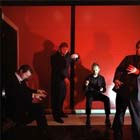Home » Jazz Articles » Album Review » Quarter Past: Smash No Flash
Quarter Past: Smash No Flash
As a group, Quarter Past makes no bones about its influences, listed as Miles Davis, John Coltrane, and Ornette Coleman. On Smash No Flash, the influence of the latter two are easy to hear, but not the first, except perhaps for the modal feel and tight walking swing of such tunes as "Piblokto and "Personology.
The dominant sound of the record, at least on the first three tracks, is the very harsh, frenetic alto saxophone of Dag Stiberg. His playing sometimes sounds as if he is squeezing his horn to death and trying to reach the highest note possible. Pianist Helge Jorgensen, however, plays exactly the opposite when he solos, using small groups of notes that are separated by seemingly unmeasured space and then going into a chordal solo, which together creates a very open feel. Drummer Kyrre Tromm Linvig and bassist Carl F. Gjerdrum keep the proceedings moving and work nicely together as a unit.
This tension then, between the piano and the sax, is what draws one's attention. At times, the sax's wailing can get tiring, not so much because of the sound, but because it does not seem to make sense, other than as a shock when juxtaposed against the mostly serene piano. "Milly and Frida, the longest track, is almost bizarre, since the theme is a pretty, folk-like melody that sounds almost strangled at times by Stiberg, but once again is answered, full of drama by now, with soft piano.
A full disc of this might be hard to take, but then comes "Solipsism, which, besides featuring an entirely different sound from the saxophone, has the clearest sense of the band being an improvisational unit. Stiberg is now playing melodically in the lower register with a smooth, silky sound. The whole band works together to produce a lush ballad aura. Soft drums and perfectly placed bass notes accompany another understated piano solo from Jorgensen. This is the high point of the record, and it's magic, even if it strongly echoes Wayne Shorter's "Infant Eyes.
Taken individually, the opening tracks of Smash No Flash show an energetic band with a solid understanding of the '60s that might be saying more than I can hear, while "Solipsism (which means "the theory or view that the self is the only reality ) demonstrates that Quarter Past can communicate very effectively with subtlety. Where they go from here is a very intriguing question.
A fine debut album, and I will be looking forward to future releases from these musicians.
Visit Quarter Past on the web when the site is up and running.
Track Listing
Bosporus; Quarter Past; Milly and Frida; Locasta; Solipsism; Personology; Piblokto.
Personnel
Dag Stiberg: alto saxophone; Helge Jorgensen: piano; Kyrre Tromm Lindvig: drums; Carl F. Gjerdrum: double bass.
Album information
Title: Smash No Flash | Year Released: 2005 | Record Label: Jejune Productions
< Previous
Nothing, Knowing
Comments
Tags
For the Love of Jazz
 All About Jazz has been a pillar of jazz since 1995, championing it as an art form and, more importantly, supporting the musicians who create it. Our enduring commitment has made "AAJ" one of the most culturally important websites of its kind, read by hundreds of thousands of fans, musicians and industry figures every month.
All About Jazz has been a pillar of jazz since 1995, championing it as an art form and, more importantly, supporting the musicians who create it. Our enduring commitment has made "AAJ" one of the most culturally important websites of its kind, read by hundreds of thousands of fans, musicians and industry figures every month.



















